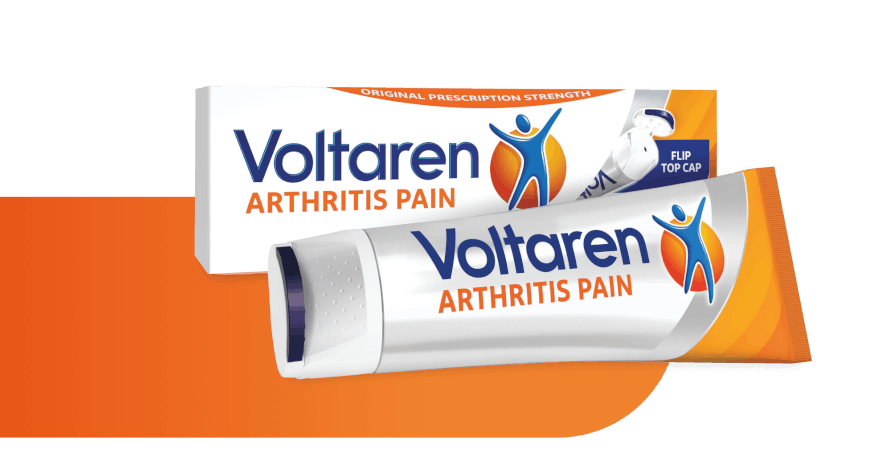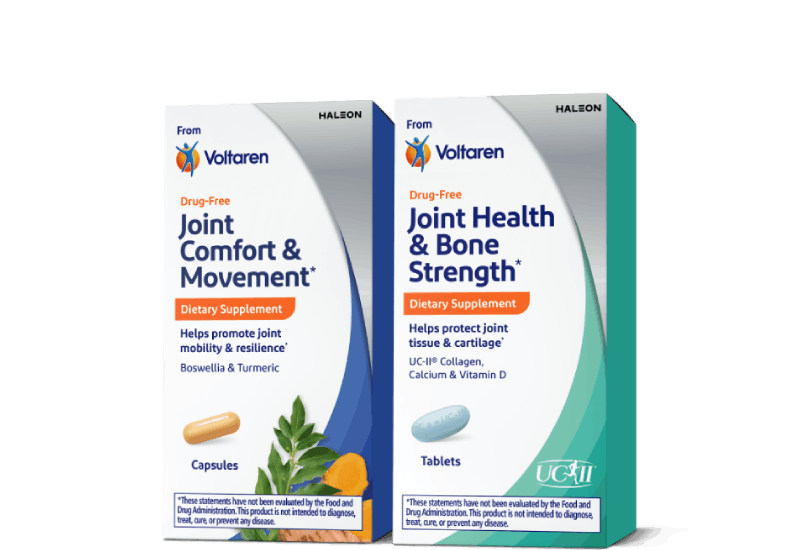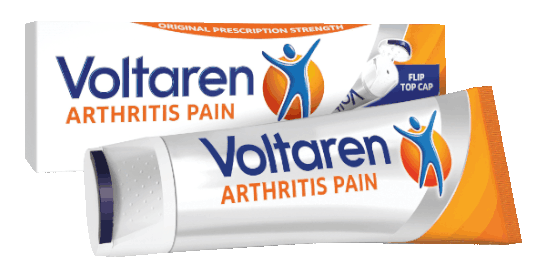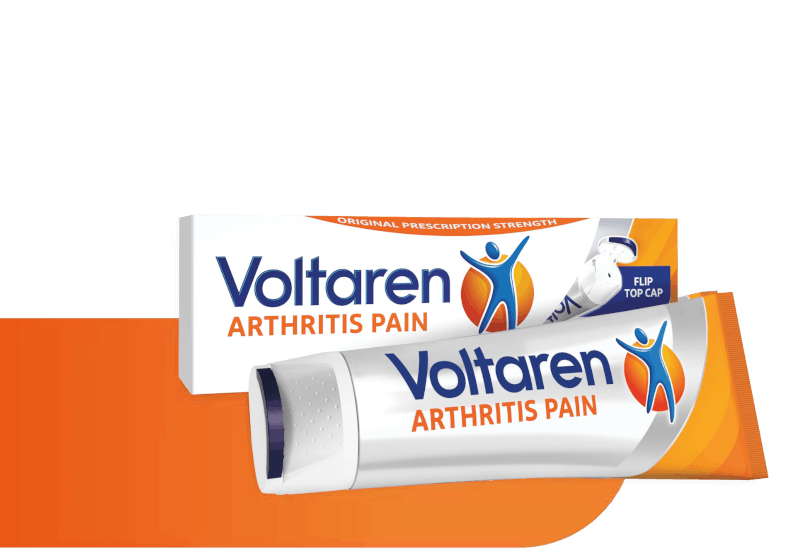Diclofenac Gel
Learn what over-the-counter diclofenac gel is, who should use it, and more.
/over-the-counter-diclofenac-gel-hero.jpg?auto=format)
If you've dealt with osteoarthritis pain in the past, you may be familiar with diclofenac. Diclofenac is a non-steroidal anti-inflammatory drug (NSAID) and it falls in the same class as drugs such as ibuprofen, naproxen and aspirin. Diclofenac eases pain and reduces inflammation like other NSAID medications. It works by blocking the production of certain enzymes in our body called COX1 and COX2. These enzymes are responsible for the production of chemicals called prostaglandins which cause pain and inflammation. So, when you block the production of COX 1 and 2, you reduce the production of prostaglandins, resulting in less pain and inflammation.1
What is over-the-counter diclofenac gel used for?
Diclofenac sodium is the active ingredient in Voltaren Arthritis Pain, an over-the-counter arthritis pain relief gel. OTC diclofenac gel is used to relieve pain from arthritis in the knees, ankles, feet, elbows, wrists, and hands.2
Over-the-counter diclofenac sodium topical gel can be good option for people who don't want to take oral NSAIDs or they can't swallow pills.
How should I use diclofenac gel?
Over-the-counter topical diclofenac comes as a 1% gel to apply on up to two joint areas, four times daily.2 These areas can include the foot, ankle, knee, hand, wrist or elbow. It's recommended to apply your OTC diclofenac gel around the same time every day. Some basic tips for application for Voltaren Arthritis Pain diclofenac gel:2,3
- Apply diclofenac gel on clean, dry skin.
- Apply the gel to two joints only. For example, a hand and an elbow, a knee and an ankle or two knees. Use your hands to gently rub the gel into your skin.
- For each upper body area (hand, wrist, or elbow), squeeze out 2.25 inches (2 grams) and apply. For each lower body area (foot, ankle, or knee), squeeze out 4.5 inches (4 grams) and apply.
- Wash your hands thoroughly after applying the gel unless you are using the medication for your hands. If so, do not wash your hands for an hour after application.
- Do not apply gel to skin that is broken, infected, cut or covered in a rash
- Diclofenac topical gel is only for external use on the skin. Be careful not to get diclofenac gel in your eyes, nose or mouth.
For external use only
Allergy alert: Diclofenac sodium gel may cause a severe allergic reaction, especially in people allergic to aspirin. Symptoms include:3
- Hives
- Asthma (wheezing)
- Skin reddening
- Blisters
- Facial swelling
- Shock
- Rash
If an allergic reaction occurs, stop use and seek medical help right away.
Liver warning: This product contains diclofenac. Liver damage may occur if you apply
- more or for a longer time than directed
- when using other drugs containing diclofenac
Stomach bleeding warning: This product contains an NSAID, which may cause severe stomach bleeding. The chance is small but higher if you
- are age 60 or older
- have had stomach ulcers or bleeding problems
- take a blood thinning (anticoagulant) or steroid drug
- take other drugs containing prescription or nonprescription NSAIDs (aspirin, ibuprofen, naproxen, or others)
- have 3 or more alcoholic drinks every day while using this product
- apply more or for longer than directed
Heart attack and stroke warning: NSAIDs, except aspirin, increase the risk of heart attack, heart failure, and stroke. These can be fatal. The risk is higher if you use more than directed or for longer than directed.
Do not use
- if you have ever had an allergic reaction to any other pain reliever or to a fever reducer
- for strains, sprains, bruises or sports injuries. This product has not been shown to work for these types of injuries.
- right before or after heart surgery
- on more than 2 body areas at the same time
- in the eyes, nose or mouth
Ask a doctor before use if
- you have problems or serious side effects from taking pain relievers or fever reducers
- stomach bleeding warning applies to you
- you have a history of stomach problems, such as heartburn
- you have high blood pressure, heart disease, liver cirrhosis, kidney disease, asthma, or had a stroke
- you are taking a diuretic
- you are under age 18 years. It is not known if this drug works or is safe in children under age 18 years.
Ask a doctor or pharmacist before use if you are
- under a doctor’s care for any serious condition
- taking any other drug
When using this product
- avoid contact with eyes, nose, or mouth
- if eye contact occurs, rinse thoroughly with water
Stop use and ask a doctor if
- pain gets worse or lasts more than 21 days
- redness or swelling is present in the painful area
- fever occurs
- skin irritation occurs
- any new symptoms appear. These could be signs of a serious condition.
- you experience any of the following signs of stomach bleeding:
- feel faint
- have bloody or black stools
- vomit blood
- have stomach pain that does not get better
- you have symptoms of heart problems or stroke:
- chest pain
- trouble breathing
- leg swelling
- weakness in one part or side of body
- slurred speech
If pregnant or breast-feeding, ask a health professional before use. It is especially important not to use diclofenac at 20 weeks or later in pregnancy unless definitely directed to do so by a doctor because it may cause problems in the unborn child or complications during delivery.
Keep out of reach of children. If swallowed, get medical help or contact a Poison Control Center right away.
Make sure to keep your diclofenac sodium topical gel in the container it came in and out of reach of children or pets. It's important to keep it out of sight and high enough that children can't reach it or see it.
Who should use diclofenac gel?
Before using topical diclofenac gel you should read the product label to determine if it is right for you. People with certain underlying medical conditions are advised to talk to their doctor before use so it is important to understand if this includes you. It may not be right for you if you already take oral NSAIDs, you have sensitive skin, or you have several affected joints.4
There are also several drugs interactions you should consider if you're considering using OTC diclofenac gel. Ask your doctor or pharmacist before using diclofenac gel if you are taking any other pain reliever or are planning on taking any other pain reliever, especially prescription or nonprescription NSAIDs (aspirin, ibuprofen, naproxen, or others).
Now that you know more about diclofenac gel, the active ingredient in Voltaren, make sure to visit our arthritis resource center to learn more about managing your arthritis symptoms.
Content contained in this article is not meant to be used as a direct indication of Voltaren product use or results.
Related Articles

What Are the Symptoms of Arthritis?
Arthritis feels different to everyone—you will likely have physical symptoms such as pain and stiffness. You might also notice emotional ups and downs as you manage this chronic condition.
READ MORE

How OTC Arthritis Creams Work
Have you ever wondered how over-the-counter arthritis creams and gels work? Keep reading to learn how applying topical pain medications can help target joint pain under the skin’s surface.
READ MORE
See How Voltaren Can Help
Save Money on Your Next Purchase.
Feel The Joy Of Movement
No matter the day, the hour, or what you’re doing, embrace the joy of movement with the help of specialized products from Voltaren: powerful gel for arthritis pain † or drug-free, dietary supplements for healthy joints.*

For Arthritis Pain Relief

For Healthy Joints*
†Use as directed. Voltaren is approved for treatment of arthritis pain.
Dietary supplements from Voltaren are not intended to treat arthritis pain.
*These statements have not been evaluated by the Food and Drug Administration. These products are not intended to diagnose, treat, cure or prevent any disease.



